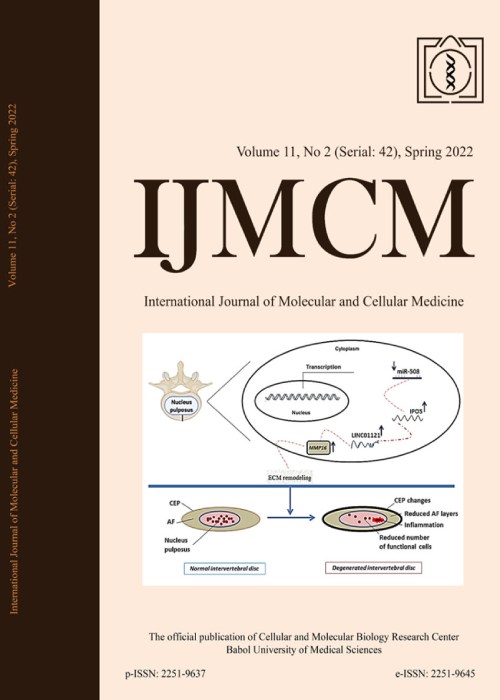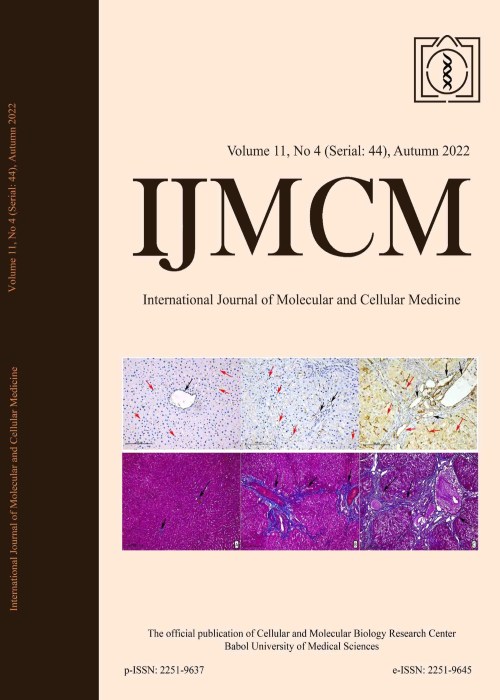فهرست مطالب

International Journal of Molecular and Cellular Medicine
Volume:11 Issue: 43, Summer 2022
- تاریخ انتشار: 1402/02/30
- تعداد عناوین: 7
-
-
Pages 180-196
To investigate the efficacy of Wharton's jelly mesenchymal stem cells (WJSCs) and their conditioned medium (CM) for corneal nerve regeneration in rats with diabetic keratopathy. Streptozotocin (STZ)-induced male diabetic (DM) rats (250–300 g) were divided to four groups (n=7/group): Control, DM, DM with WJSCs (DM+WJ), and DM with CM treatment (DM+CM). DM+WJ and DM+CM group received WJSCs or CM, respectively, topically by eye drops. Corneal sensibility, corneal epithelial layer integrity, histology, expression of GAP-43 and TUBB3 on mRNA level and their immunohistochemical expression were examined after two weeks of treatment. There were changes in corneal sensibility and corneal integrity between normal control and diabetic groups with/without WJSC or CM injection. Total central corneal thickness was significantly higher in DM+CM (249.81 ± 43.85 μm) than in control (174.72 ± 44.12 μm, p=0.004) and DM groups (190.15 ± 9.63 μm, p=0.03). GAP-43 mRNA expression levels of DM+WJ and DM+CM groups were higher compared with DM and control groups. TUBB3 mRNA level was increased after CM (p=0.047), but not after WJSCs treatment (p=1.00). GAP-43 and TUBB3 immunohistochemical expression of nerve fibers along the epithelial layer significantly increased in DM+WJ and DM+CM compared with DM group. Our findings showed that WJSCs and their CM improved corneal nerve regeneration in rats with diabetic keratopathy.
Keywords: Stem cells, Wharton's jelly, conditioned medium, diabetic rats, GAP-43, TUBB3 -
Pages 197-206
In this research, we investigated microRNAs (miRNAs) expression profile in MCF-7 breast cancer cell line which treated with 150 µM vitexine. Profiling of miRNAs expression was performed using TaqMan MiRNA Array. Apoptosis was analyzed by flow cytometry and the expression of some genes involved in "anti-proliferative" signaling pathways were evaluated by western blotting and real time PCR methods. Twenty microRNAs were differentially expressed in vitexine treated cells compared to the control. Among them, let-7-b,c were up regulated while miRNA-17-5p was down regulated with highest score. Also, we detected the expression changes of mentioned miRNAs target genes as well as genes involved in caspase apoptosis pathways. Our results provide the first evidence that vitexin can effect miRNA expression in MCF-7 cells. Also based on our finding, vitexin can be an attractive miRNA mediated chemo preventive and therapeutic agent in breast cancer.
Keywords: Vitexin, MicroRNA, breast cancer, apoptosis -
Pages 207-222
Transplantation of H-AdMSCs may improve heart function after MI. AVP is a neurohypophyseal hormone that reduces cardiovascular damage. This study investigated the role of AVP preconditioning in the survival of MSCs and their effect on myocardial repair in the MI rats. H-AMSCs were isolated and incubated for 3 days. The expression of oxytocin and vasopressin receptors was evaluated by Real-time-PCR. Forty male Wistar rats were divided into 4 groups: control, sham, ASC and AVP-ASC. Ischemia was established by ligation of LAD coronary artery. Electrocardiography, fibrosis, angiogenesis, and apoptosis in myocardium were determined after 7 days. Results showed that preconditioned MSCs significantly increased cardiac function when compared with group that received non-preconditioned MSCs. This was associated with significantly reduced fibrosis, increased vascular density, and decreased resident myocyte apoptosis. Results indicate that AVP preconditioned MSCs can be consider a novel approach to management of MI.
Keywords: Myocardial infarction, Arginine vasopressin, fibrosis, apoptosis, angiogenesis, mesenchymal stem cells -
Pages 223-235
Cerebral ischemia is a common neurodegenerative disease in which damage to the blood-brain barrier (BBB) is the main consequence. In cerebral ischemia, the level of miR-149-5p and tight junction proteins are decreased, while the level of Calpine is increased, finally leading to increased BBB permeability. This study investigated the effect of miR-149-5p mimic on the expression of Calpain, Occludin, and ZO-1 and the consequences of cerebral ischemia. Cerebral ischemia model was performed via middle cerebral artery occlusion (MCAO) method on female Wistar rats. Four groups of Wistar rats were studied: Sham, cerebral ischemia without treatment, Scramble miR, and miR-149-5p mimic treatment. Then, neurological defects and BBB permeability (via Evans blue staining), cerebral edema (cerebrospinal fluid percentage), and ZO-1, Occludin, and Calapin expression (by quantitative real time- PCR) were investigated. qRT-PCR results showed miR-149-5p expression decreases after cerebral ischemia induction. In addition, Occludin and ZO-1 expression significantly increased in miR-149-5p group. In contrast, Calapin expression, BBB permeability, brain water content and neurological defects were significantly decreased. It seems that the increased level of miR-149-5p exerts its protective effect on cerebral ischemia due to increasing of tight junction proteins.
Keywords: Cerebral ischemia, middle cerebral artery occlusion, miR-149-5p, tight junction -
Pages 236-243
Capsaicin is a natural product which is extracted from pepper and has the potential to be used in cancer treatment because of its anti- proliferative effects. The aim of the study was to determine the effect of capsaicin on the hepatocellular carcinoma cell proliferation and the expressions of related genetic markers as Ki-67, PI3K/AKT/mTOR and epigenetic markers as miR-126 and piR-Hep-1. The inhibitory concentration of capsaicin in HepG2 cells was determined. piR-Hep-1 and miR-126 expressions and Ki-67, PI3K, AKT and mTOR gene expressions were examined by RT-PCR. The inhibitory concentration of capsaicin for HepG2 cells was 200 nM and the decreased proliferation was observed at 24th hour. As epigenetic markers, an up regulation of miR-126 and down regulation of piR-Hep-1 expression were determined after treatment. Moreover, Ki-67, PI3K and mTOR gene expressions decreased while AKT gene expression increased after the treatment (p<0.001). According to the obtained data, capsaicin has an impact on proliferation both genetically and epigenetically. Furthermore, treatment of capsaicin effects miR-126 and piR-Hep-1 expressions which effect carcinogenesis in different way. Moreover, there are some clues which indicate that these two small non-coding RNA might affect each other and share the same target molecules post-transcriptionally.
Keywords: Capsaicin, miR-126, piR-Hep-1, PI3K, AKT, mTOR signalling -
Pages 244-259
Current cancer therapies include chemotherapy, radiation therapy, immunotherapy, and surgery. Despite these treatment methods, a major point in cancer treatment is early detection. RNAs (mRNA, miRNAs, and LncRNA) can be used as markers to improve cancer diagnosis and treatment. This research examined how radiotherapy affected CCL5, miR-214, and MALAT-1 gene expression in the immune pathway in peripheral blood samples from radiation therapy-treated breast cancer patients. Before and after radiotherapy, peripheral blood was collected from 15 patients in four steps. Blood samples were collected in an outpatient facility from 20 healthy female volunteers with no history of malignant or inflammatory conditions. RNA was extracted from the blood samples and cDNA was synthesized. CCL5, miR-214, and MALAT-1 gene expression were determined by real-time polymerase chain reaction (RT-PCR). CCL5 protein levels in the serum were determined in 80 samples (60 BC and 20 healthy controls) using Quantikine Enzyme-Linked Immunosorbent Assay (ELISA) kits (R&D Systems). The data was then statistically evaluated. There was a significant difference between CCL5 levels in tumoral and adjacent normal blood samples (p < 0.05). The results also show that the level of gene expression and serum concentration of CCL5 protein in different phases of radiotherapy is significantly different. On the other hand, the expression level of the miR-214 gene was significantly decreased in patients compared to the control group, but this decrease was not significant for the MALAT-1 gene (p< 0.05). Also, after each stage of radiotherapy, the expression level of these two genes showed a decrease, but in the fourth week after radiotherapy, this decrease was significant (p< 0.05). Radiotherapy is associated with a decrease in the expression of miR-214 and MALAT-1, as a result, an increase in the expression of CCL5. An increase in the concentration of CCL5 protein is accompanied by an increase in the level of monocytes, which ultimately causes the infiltration of macrophages and can ultimately cause cancer recurrence. It is suggested that these genes can probably be used as diagnostic and therapeutic radiotherapy markers in breast cancer.
Keywords: Breast cancer, Radiotherapy, ELISA, miR-214, CCL5, MALAT-1 -
Pages 260-272
The mRNA vaccines replace our conventional vaccines (live-attenuated and inactivated vaccines) due to their high safety, efficacy, potency and low cost for their manufacturing. Since these many years the usage of these mRNA vaccines have been restricted as there are unstable and their low efficiency in in-vivo delivery. But now, these problems have been solved by recent technological advances. Many studies conducted in animal models and humans demonstrated the good results for the mRNA vaccines. This Review provides you a detailed overview of mRNA viral vaccines and considers the current perspectives and future prospects.
Keywords: mRNA, vaccine, virus, lipid nanoparticle, codon optimization


